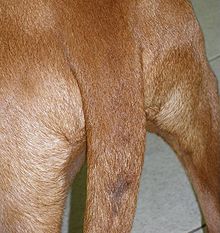Viold gland
The violet gland (also Violsche gland) is a scent gland in canids on the upper side of the tail. It is a special form of the caudal glands ( glandulae caudae , organum caudae , dorsal tail organ ). It is a collection of large sebum glands . The gland produces a typical odor that plays a role in communication in these animal species ("violwittern"). The secretions of the vial gland in foxes contain volatile terpenes that are reminiscent of the odor of violets , which gave this gland its name.
In domestic dogs this gland is designed very differently. In some dog breeds, such as the bull terrier , it is often trained, but it can also be rudimentary or completely absent. It lies on the upper side of the tail at the level of the 9th caudal vertebra. Under the influence of androgens , hair loss can occur in all breeds at this point ("stud tail"), which particularly affects older males.
An organum caudae is also formed in cats . Here it is right at the top of the tail root.
Individual evidence
- ↑ a b c d Hanns Geyer: Specific skin glands on the trunk and tail . Franz-Viktor Salomon et al. (Ed.): Anatomy for veterinary medicine . 2nd ext. Edition. Enke-Verlag, Stuttgart 2008, ISBN 978-3-8304-1075-1 , pp. 643-645.
- ^ Karl-Heinz Habermehl: Textbook of the anatomy of domestic animals . Volume 3, Georg Thieme Verlag, 2005, ISBN 3-8304-4164-9 , p. 473.
- ↑ D. Feddersen-Petersen, F. Ohl: Expression behavior in the dog. Gustav Fischer Verlag, Jena / Stuttgart 1995.
